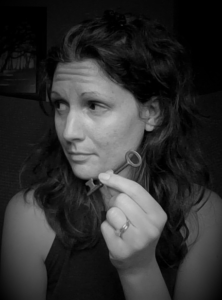The puzzle piece is becoming more and more stigmatized in the autistic community, and I completely understand why. As the symbol becomes more known to originally represent
something “missing” from autistics, the more the autistic community is rejecting its use.
By Baylie Nixon
It’s been too long since I’ve written my last article. In addition to the chaos befalling the world right now, a lot has happened in my own life too. I am finally finished with school, board certified to practice medical technology, and ready to enter the workforce. I am now officially a board member of the Autism Society of Oregon.
What is most relevant to this article, is that I did a major audit of my merchandise because I’ve decided to no longer use the puzzle piece in my work.

Even the Autism Society of Oregon is replacing its usage with the rainbow infinity. To me, that’s huge.
I’d go into more detail as to why that’s huge, but I think that’s for another article. For this blog entry, I want to stick to why I’m not using the puzzle piece anymore, why it took me as long as it did to not use it, and why I actually don’t feel that upset with people who still do.
I used the puzzle piece for as long as I did because developed a special connection to the symbol long ago, as early as middle school. Before the knowledge of the history of the puzzle piece became as prominent as it is today, I took it to mean that we are diverse and meant to have our own way of fitting in.
I also took it to represent the complexity of the autism spectrum, but not in a negative way.
After I learned the history of the puzzle piece, I was still hesitant to let go because I’m not quick to leave things with which I’ve developed a special connection.
I felt safe in continuing the use of the puzzle piece because
1) I am autistic myself, and I was under the impression that it’s okay for autistics to use it,
2) I believed the symbol was still redeemable, and
3) Autism Speaks does not have a monopoly on the puzzle piece, so I figured that disowning their puzzle piece logo in particular was good enough.
Overtime, it’s become apparent that use even by autistics is shunned within the community, and I was surprised by that.
I thought that because I’m autistic, I can use whichever symbol I want in order to express my pride and promote our cause. But ever since I received backlash for my continued usage, I knew I needed to reevaluate how I express my support for the community.
I decided to discontinue my association with the puzzle piece, which includes my jewelry.
However, unlike many of my peers, I still didn’t feel the same hostility towards those who use the symbol.
The reason I don’t feel anger at people who use the puzzle piece despite the fact that I don’t approve of the symbol anymore is because I don’t think most people who use it have prejudiced intent. Every person I’ve met who’s familiar enough with autism to have puzzle garb, but not familiar enough to understand the controversy accompanying it, has been supportive, understanding, and empathetic when I’d explain our plight.
Now, should people who claim to support us put more effort into knowing how to properly support us? Of course.
Yet I don’t expect people to know everything about us from the get-go, and I certainly don’t feel right shooting down someone’s effort to support us with a blunt “I’m offended” or “you’re doing that
wrong.”
I mean, I know how it feels to put effort into trying to be helpful and supportive, only to have it met with harsh criticism. It makes me feel as if I shouldn’t have tried at all, therefore I
don’t want to impart those same feelings onto people who clearly mean well.
This doesn’t mean I won’t take time to educate people when I think it’s appropriate. In fact, it can be a very welcoming experience for both parties to have an open dialogue about this.
I had such an experience as a student in the lab of my local hospital. Part of my activism is being openly autistic in my profession, and the people I’ve worked with have been incredibly
supportive.
Back when I still identified with the puzzle piece, one of my coworkers wore a puzzle scrub.
I complimented her when she came by my workstation, and that’s when she smiled and said “I wore this for you.”
I felt nothing but warm fuzzies from her gesture. But as I departed from the puzzle piece and saw the kind of anger it stirs up, I couldn’t help but feel concerned too.
I didn’t want her to find herself in a situation autistics find themselves all too often: We don’t understand the nuance of a situation, mess up in ways an NT wouldn’t have, and then we get attacked for it without knowing what we did wrong. Rinse and repeat until the same kind of people who attack us wonder why we’re so self-conscious.
After mulling it over some more, I figured out a way to educate her without coming off as unappreciative of her gesture.
We ended up having a pleasant conversation via email about autistic culture, activism, and how allies can better help.
She was very happy to learn about how to more appropriately support us.
The thought of a neurotypical experiencing the social ambushing autistics often go through might encourage feelings of schadenfreude among the most disgruntled in our community.
I’ll admit, there are times when I feel that way too.
Alas, if the neurotypical in question is a good person who tries to do right by us, it just doesn’t feel right jumping on a chance to punish them for a privilege they cannot help.
Save it for the people who don’t care that their behaviors could be harmful. Even though the problematic history of the puzzle piece has been exposed, those facts are still obscure to those not familiar with our culture.
Even if someone isn’t aware of the puzzle’s controversy, I just can’t help but be happy when they express interest in us nonetheless.
Editor’s Note: The Art of Autism nonprofit does not use the puzzle piece image in our promotions or our logo.

My name is Baylie Nixon, I am 26 years old, and I am currently living with my family while I begin my career as a medical technologist. I am on the autism spectrum, diagnosed with Aspergers before the DSM V was published, and have been a strong advocate for autistic inclusion since I was a junior in high school. My activism really took off during senior year of high school when I did my senior project on neurodiversity, and then later in college I was in charge of a neurodiversity club for a year.
I recently graduated from George Washington University Online with a post-baccalaureate certificate in medical lab science. I have lived in Southern Oregon for half my life, while also having lived in Forest Grove to go to Pacific University for a couple years, spending another couple back home at Southern Oregon University, then finally finishing my bachelor’s in Corvallis. I am absolutely in love with the biomedical sciences, and am excited to put my knowledge and passion to good use. I am also an Etsy jeweler, my shop is called “Bao Treasures,” and its logo is a rainbow bird. Because of my business, I joined the local Chamber of Commerce to promote my merchandise. I have been making jewelry for just over half my life.”









Thank you. my biggest objection to the puzzle piece is that many non -autistics who use it do beleive autitics in genearl are damaged, chidlish, and incompklete. they want to promote awareness of autism, but not acceptance.
Not all, but enough that i cringe when i see puzzles, wodnign if this is someone who thinks i am inferior or doesn’t care how I feel.
I appreciate this piece as well as your willingness to revise your position in light of new information. Well done, and keep up the positive representation. 🙂
I’m a little late here, but wanted to say that I couldn’t agree more with your position. As you say, the difficulty would be deciding if/when/how to explain this to a well intentioned ND.
I’ve had similar experiences with having my well meaning but sometimes naïve intentions being thrown back at me in an off-putting way. Let’s not do that to others.
I see the puzzle piece(s) in a different way. I believe that it symbolizes the many facets of autism…that there is no “one size fits all” and we may need to continue to look for solutions and supports beyond the stereotypical characteristics that often generically represent what “autism” means.
This so-called new symbol looks like it came from the pride movement.
The overtime and division created by snobbery predicated on virtue signaling. Pathetic.
theres’ nothign snobbish or virtue signallign about disliking a hate signal, even if it is used in ignorance. askign someoen ot stop hurting you is not snobbihs.